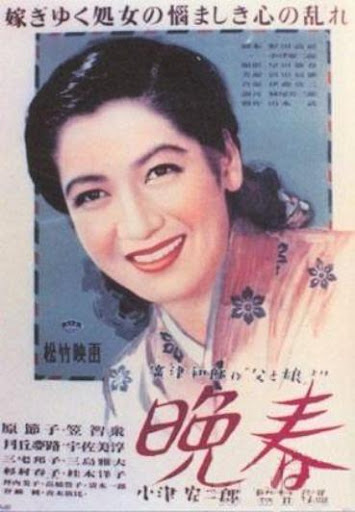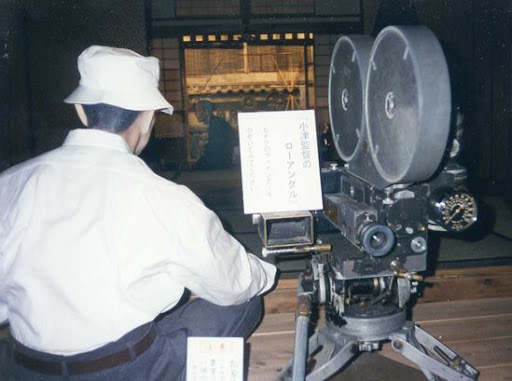
What would Antonioni have been without Monica Vitti? To answer that would be pure conjecture, but the bigger question, one that trancends the film idiom, would be: What would the young female in post-war Japanese society have been without Yasujirō Ozu and Setsuko Hara? It's hard to imagine the impact that Ozu and his muse had on a country that had been stripped of its dignity through war, then slowly westernized by the Marshall plan and Demming economics. Ozu and Hara held the country's hand through these troubling times, and to be able to peer fity years later through the masterful eyes of Ozu is the perfect blend of post-war history and art. To this day I melt when Setsuko Hara smiles, and I hope that I never quit melting when viewing their films. Here's the BluRay rip of Banshun/Late Spring. Tôkyô monogatari/Tokyo Story will soon follow.

From Michael Atkison:
Maybe it is something to do with the sensual seductiveness of cinema: as new-millennium Americans, we care nothing for Japanese poetry, little for Japanese painting and fiction, and certainly too much for Japanese cartoons, and yet Yasujiro Ozu, the least sensational filmmaker of all time, remains on our docket, calm as ever, seething with semispoken disappointments, visually blocking out Nippono bourgeois life maps with guileless wisdom. By all rights, an Asian artist of such sublime restraint should have been long forgotten in our ethnocentric, hyperventilating digital-viscera mind-set, but here he still is, evoking new scholarship, igniting theatrical retrospectives all over again, being lovingly and enthusiastically bronzed on DVD, one precious film at a time. An enormous amount of literature has been generated about Ozu’s work, but a few line items need to be reaffirmed: He is one of the very few cinema giants you could never accuse of pretension (Jean Renoir, Luis Buñuel, and Robert Bresson are the others). He remains movies’ most disciplined creative voice—a matter of no small magnitude in a medium naturally prone to the infantilization of noise, speed, and bright colors. Each film is a raw lesson—new in our presence, if not terribly different than twenty others—intended to realign in our hearts what movies are good for.

It’s a cliché now to posit Ozu as the “most Japanese” of that nation’s great directors, but it still seems true. His focus on the society’s transitional struggles, quotidian living spaces, and enjoyable norms was not only unflagging (more than fifty films in a thirty-five-year career) but embodied in the very shape of his compositions and in the reasoning behind his cuts. But it’s not Japaneseness per se that draws us; why would it, after all? It is something more fundamental—a quintessential aspect of the medium, a breath-catching nexus of time elapsed and empathies shared. It just so happens that Ozu’s Zen-infused sensibility translates on film to something like the art form’s nascent formal beauty: patiently watching little happen, and the meditative moments around the nonhappening, until it becomes crashingly apparent that lives are at stake and the whole world is struggling to be reborn.Like many Ozu movies, Late Spring (1949) is a triumph of sympathetic, respectful clarity and a surgical strike at the heart, but it also stands alone as a turning point in his development as a sociopolitical artist. It is, first of all, the magisterial archetype for the shomin-geki—the “modern family drama”—a genre Ozu helped define and that remains his kingdom to reign. (To genre-ize Ozu at all seems odd, so intense is his formal signature. Even so, drama is the odd word out here; the textures of Japanese life and the rhythmic bolero of Ozu’s stories deliberately subsume the dramatic in favor of the internal.) But the family in that equation wasn’t exactly what it was before the war, and Late Spring is the first of his films made after those horrors to try to imagine what Japanese domesticity might look like in this new world. Comparatively (by an Ozu measure), Record of a Tenement Gentleman (1947) and A Hen in the Wind (1948)—his first two postwar works—are scabrous portrayals of a corrupt, demilitarized, firebombed landscape that swallows the vulnerable. It was as if Ozu needed to vent the war’s pus from his psyche. With Late Spring, he dresses the wound and moves toward his true aesthetic protocol; life during the reconstruction is viewed by way of the quiet tensions of generational conflict.

The low-intensity but painful warfare between domestic Japanese traditionalism and modern liberations and feminism—between the insecure old and the restless young—is Ozu’s range to patrol, and here it is realigned after wartime and complicated implicitly by signs of encroaching Americanization. (Was Ozu the first filmmaker to use the Coca-Cola logo as a symbol for rampaging Yankee capitalism? He certainly beat Jean-Luc Godard and Billy Wilder to the punch.) Indeed, postwar society (suggested further by discussions of treated anemias and glimpses of the Saturday Evening Post) let Ozu raise the stakes. What simmered as a timeless stew of generation-gap disconnect in the earlier films became, with Late Spring, a thunderously specific social dynamic. In the thirties, society was changing and Westernizing at a familiar pace, but in the postwar world, as Ozu suggests in his inimitably respectful way, the old-fashioned lifestyle was under siege by commercialism, permissiveness, antimasculinism, and independent wives and daughters. Suddenly, the struggle to guide youth with ancient values wasn’t just a manageable matter of course but a project doomed to failure by progress itself.

Still, Ozu’s scenario isn’t a generational throw-down. What he depicts in this, his inaugural seasonal film, the first ideogram in a dozen-year exploration of parent-child relationships, is an altogether subtler dilemma. Loving, grown, contemporary-minded daughter Noriko (Setsuko Hara) lives with her gentle, if slightly distractable, professor father (Chishu Ryu); an irritating aunt (Haruko Sugimura) suggests the young woman should marry, and soon. (The matter of the father’s caretaker-requiring “eccentricity” is mostly taken for granted, although his capabilities as a scholar seem under question when he confuses Franz Liszt with economist Freidrich List.) Believing he is doing the right thing, and in order to allow his daughter to detach from him and his daily needs, the father begins talking about taking a new, younger wife. Despite Noriko’s self-reliance—an Ozu earmark from the thirties that became an axiom in Late Spring—the acquiescent, ever-smiling heroine’s desires are never considered; she explicitly asks why her contented life cannot just go on as it has been.
But can it? What would be the best path for her to follow? Far from a Manichaean take on the oppressive power of lingering social norms, Late Spring is a hushed battlefield where no one is right or wrong. We watch the infliction roll out inexorably, wishing there were a cheesy, American-style resolution somewhere on the horizon in which all of the well-meaning characters could be happy. But that’s not Ozu. Ozu is the natural energy of Noriko’s generous grin, dispensed selflessly in all social situations, until she realizes where her life is helplessly headed—and the blood-cooling shock of seeing that resilient smile finally drop.

Justly praised for his temperate, rigorous form, Ozu is actually something of a calculating whammy master, and Late Spring saves its crushing blows for the very last shots and the simple peeling of an apple. But Ozu’s methodology in Late Spring, which became an almost ritualized discipline in his subsequent films, expresses so much more than mere character and narrative: the famous still-life cutaways (themselves a codex of Zen commentaries and signifiers) and tatami-mat-high point of view; the compressed depth of the family’s rooms (Noriko and company pass in and out of sight through doorways we cannot see, suggesting haunting layers of quotidian complexity); the fastidious commemoration of the uniquely careful Japanese living spaces (that no culture has thought as much about the composition and physical meaning of their own homes is not a point lost on Ozu); the vivid manner in which the architectural precision expresses the controlled tone of relationships. There’s an acute sense of home here, happily inhabited, that is unaccented and yet fuels Noriko’s tragedy. (Contrast it to the ill-fitting urban rooms suffered by the elderly couple visiting their ruinous children in Tokyo Story, from 1953, or the inverse discomfiture of the visiting actor in the home of his former lover in 1959’s Floating Weeds. Ozu’s palette may seem uniform from film to film, but it often yields very different atmospheres.) Late Spring can be seen as Ozu’s first absolutely crucial work, a step toward understanding the ripple effects of the postwar age among ordinary citizens—or, if that’s not possible, then at least capturing them in compassionate amber.

Technical Information:
Title: 晚春/Banshun/Late Spring
Year: 1949
Country: Japan
Director: Yasujiro Ozu
Source: BluRay Retail
Video Codec: 720p-x264
Container: .mkv
Size: 4.36 GB
Length: 1:47:58
Programs used: Unknown
Resolution: 960X720
Aspect Ratio: 4:3
Video: MPEG4 H264 @ ~8600 kb/s
Frame Rate: 23.97 fps
Audio: Dolby AC3 pass-thru Japanese @ 448 kb/s
Subtitles: English
Thanks to team titans for the original rip and upload!

(Our prefered x264 player is Media Player Classic.)
Late Spring Megaupload Links


